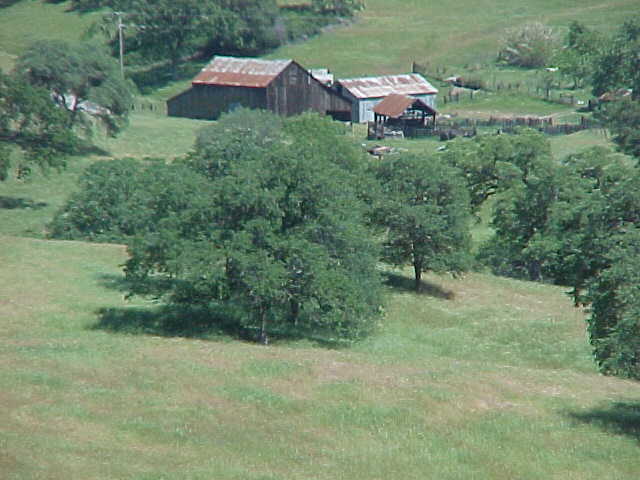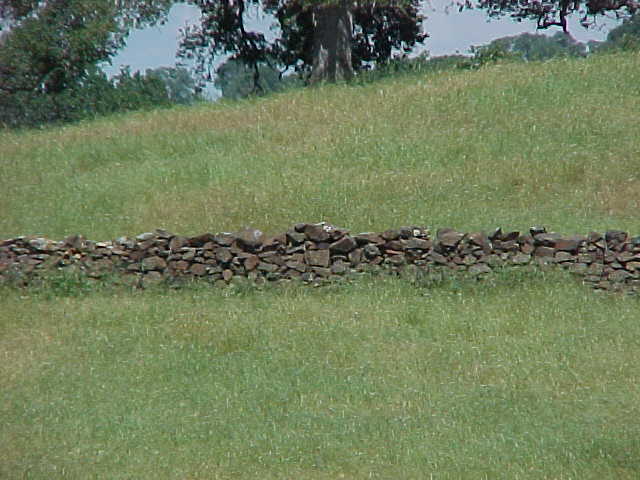 California
CaliforniaHistory and Genealogy Research
PHOTOS TAKEN FROM BEN HUR RD OF THE QUICK RANCH
photos by C Feroben -2002

ROCK WALL ON THE QUICK RANCH PROPERTY

ROCK FENCE IS LABEL OF HISTORY ON QUICK RANCH
Fresno Bee, Sunday June 13, 1954
Mariposa -Mariposa Co. Throughout the Mother Lode county are the remains of the hundreds of miles of rock fences which once encompassed the holding-large and small- of the pioneers and their sons, but the longest one still in use probably is that on the historic Quick ranch on Rancheria Creek about 12 miles southeast of Mariposa.
The stone barriers served two purposes for the early settlers. They provided barriers which kept roving animals out and their own stock in, and they supplied the answer to the problem of what to do with the rocks which had to be removed before the land could be tilled.
Chinese coolies, working for 25 cents a day did most of the construction, and they were required to lay one and a half rods of fence each day or they forfeited their pay. The fences were 2 1/2 feet wide at the bottom , 4 feet high and 12 inched in width at the top.
The services of the coolies were provided by Oriental contractors who were paid a standard fee of $1.75 for every rod of fence put up.
Extensive Landmarks
Traces of the rock enclosures still are visible on the hillsides from Mariposa County north to El dorado County and some of them stretched down into the San Joaquin Valley flatland.
Four hundred of the Quick ranch's 3,000 acres still are enclosed by a five mile stone fence which ws built in 1862 at the direction of Morgan W. Quick, R., the grandfather of the present owner, Guy E. Quick.
The elder Quick came to Mariposa County in the fall of 1849 and staked a claim near the mouth of Oak Spring Creek, a couple of miles above what now is the town of Mariposa.
The fine gravel was rich in gold and Quick averaged $10,000 a year for the next nine years.
He built a small adobe house, set out fruit trees and vines and, in 1854, married a Sacramento girl, Deborah Stuart.
The nucleus of the Quick ranch was a brush fenced 160 acre homestead which Quick bought from a Dr. L. Harris in 1859 for $250. Of Dr. Harris, little is known, but he must have been an interesting character. Despite his doctorate he still was unable to write, and the deed is signed with an X.
Wire Fence Builder
Quick brought in the first Morgan horses to Mariposa County, built the first barbed wire fence in this part of California, and acquired the first hay press- a hand operated contraption built in Pennsylvania in 1856. The old press, kept on the ranch until recent years, now is in a museum in Southern California.
Quick built up a herd of purebred Hereford and Durham cattle and, in 1864, registered the Quick brand which still is in use and is one of the oldest in the state. He dug wells, put in pumping plants, cemented up several springs and installed watering troughs for his stock, something almost unheard of in those days.
Meanwhile, his two sons, Mark and Morgan W. (Tom) Quick Jr., were growing up and taking an increasingly important part in the operation of the expanding ranch. In the late 1870's the elder Quick retired, turned over the management of the place to the sons, and bought an apple orchard in Watsonville. But he retained an active interest in the Mariposa home place until his death in 1903.
In 1904, Guy E Quick the son of Morgan W. Quick, Jr., joined his father in the operations of the ranch and, in 1912, they bought the county's first gasoline powered truck- a venture which caused much head shaking among the other farmers and brought forth predictions f the Quick's shortly would go broke, spending their money for such newfangled contraptions.
That was the same year the old Ben Hur Post office ws moved to the Quick place, and Mrs. Guy Quick became the postmistress. She retained the job until the office was discontinued 39 years later.
The postoffice was the half way point on the old stage road between Raymond and Mariposa. The mail was hauled by a two horse state which made the 52 mile round trip daily. Horses were changed four time along the way.
Changes Breeds
Morgan Quick, Jr., died in 1922, leaving the ranch to his son. In 1927, the younger Quick changed from the Hereford and Durham shorthorns with which the ranch up to then had been stocked, and brought in polled Herefords.
now 70, Quick retains his youthful vigor and has no intention of retiring- at least not right away. He and Mrs. Quick will celebrate their golden wedding in 1856 and then it will be time enough to think about taking it easy.
When that time comes, there is no danger the ranch will leave the possession of the family.
For the Quick's have two sons and two grandsons, and it already has been arranged by right of survivorship for title to pass eventually to the latter.
And that ill make it five generations of ownership by the same family of the $3,000 acres of green hills and lush valleys which began as the brush enclosed quarter section homestead of a doctor who could not write his own name.
READ MORE ABOUT THE QUICK RANCH
RETURN TO MARIPOSA COUNTY PHOTO ALBUM
TOUR BEN HUR RD
Search the complete Mariposa History and Genealogy Website for more information on the Quick Family